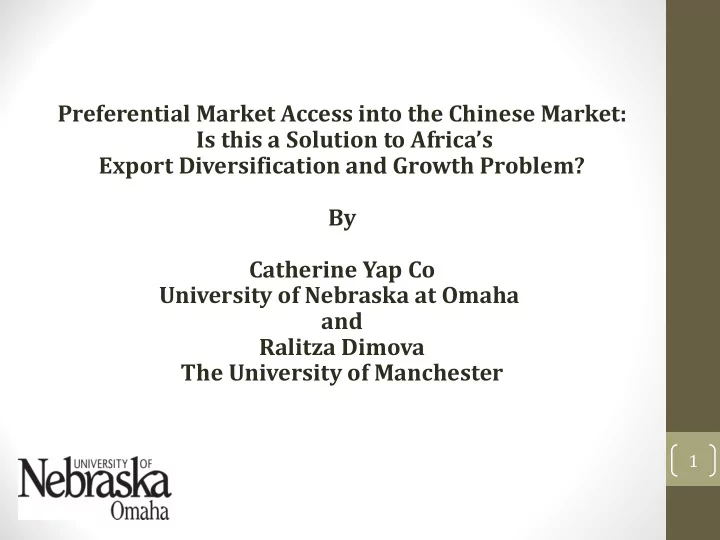

Preferential Market Access into the Chinese Market: Is this a Solution to Africa’s Export Diversification and Growth Problem? By Catherine Yap Co University of Nebraska at Omaha and Ralitza Dimova The University of Manchester 1
Introduction • China’s current engagement with Africa is an important example of south-south cooperation. • One of the priority areas of the United Nations’ Development Cooperation Forum (DCF). • DCF tracks the progress and coherence of countries’ international development cooperation activities. 2
Introduction • “South-South cooperation has features that set it apart from North-South cooperation, such as absence of conditionality….” ECOSOC (2010, p. 7) • Mutually beneficial exchange is a core characteristic of south-south cooperation. 3
Introduction • Developing SSA GDP growth, 2011: 4.7%. • Worldwide rate: 2.7% (World Bank, 2013). • Mo Ibrahim index on safety and rule of law shows that a third of the countries in SSA experienced improvements in governance while two-thirds of countries experienced increased sustainable economic opportunities in 2006-2010 (Mo Ibrahim Foundation, 2011). 4
Introduction • Africa’s challenges related to international trade remain two-fold: • overcoming supply-side constraints (see e.g., Collier and Venables, 2007); • overcoming market access constraints (see e.g., Chuhan-Pole and Angwafo, 2011; Mshomba, 2009). 5
Introduction • China’s preferential market access program (duty-free) addresses market access constraints. • US’ African Growth Opportunity Act (AGOA, 2000) which provides duty-free access to US imports of more than 6,400 items from eligible SSA countries until Sept. 30, 2015. • Europe’s ‘Everything But Arms’ program. 6
Introduction • China-Africa engagement is not a recent phenomenon. • Brautigam (2009). The Dragon’s Gift. • Forum on China-Africa Cooperation (FOCAC): main venue for collective dialogue between China and 49 African member states since 2000. 7
Introduction • Preferential market access (duty-free access) was first promised at the 2 nd FOCAC Ministerial Conference in 2003. Pre-program Phase I: 2005-2007 Phase II: 2008-2010 2002-2004 25 countries 6 more countries 190 items 254 more items Notes: Post-WTO entry (12-11-01). Program expanded to more than 4,700 items since July 2010. 8
Introduction • Main research question: • Whether Chinese imports of preference- eligible products from preference-eligible countries during the preferential period is higher. 9
Data • Trade data at the six-digit Harmonized System (HS) codes level from UN Comtrade. 10 Notes: ** included in the preferential list. Petroleum share in 2002 was 0.83; Cathodes share was 0.01.
11
Methodology • 1) Measuring the trade growth implications of the program: • a) Sample: Only preference-eligible SSA countries. Did imports of preference- eligible products from these countries increase? 12
Methodology • 1) Measuring the trade growth implications of the program: • b) Sample: Only preference-eligible products. Did imports of these products from preference-eligible countries increase? 13
Methodology • 1) Measuring the trade growth implications of the program: • c) Sample: All countries (193), all products (5,215) 14
Methodology • 1c) We follow Frazer and Van Biesebroeck’s (2010) triple-differencing approach. 15
Methodology • Positive coefficient is expected for the triple interaction terms. • Upon implementation of the preferential market access program, imports of preference-eligible products from preference-eligible countries are expected to increase. 16
Methodology • 1c) Another way to think of triple interaction term. Time change Time change Time change in imports of in imports of in imports of preference- preference- preference- eligible eligible non-eligible products products products from from from preference- preference- preference- eligible non-eligible eligible countries countries countries (period) (product) (country) 17
18
Results 19
20 Qualitatively similar results for Phase II.
Results • Negative coefficients suggest that China’s preferential market access program has not had the intended effect of increasing trade from low income SSA countries in the selected products. • In fact, imports of preference-eligible products from preference-eligible SSA countries are lower upon program implementation. • Why? 21
Results • Because crude petroleum continue to dominate these countries’ exports to China. • However, there are some signs that with time, some SSA countries might be able to overcome their over-reliance on raw material exports and constraints in their ability to transition to products with slightly more value added. 22
Methodology • 2) Export diversification and moving up the value chain. • China’s preferential trade program improves the export diversification potential of the African partners? • Or, does it further entraps these countries into primary resource-based production and exports? 23
Methodology • 2a) Exporter product concentration 24
Methodology • 2b) Export sophistication 25
Results 26
Results • Single out: Democratic Republic of the Congo (DRC) and Zambia. • Rather than raw ores and minerals, the DRC and Zambia are now exporting processed ores and minerals to China. • They have also experienced gains in market share. 27
Results 28
Implications 29
Implications 30
To conclude: Preferential Market Access into the Chinese Market: A Solution to Africa’s Export Diversification and Growth Problem? 31
Recommend
More recommend